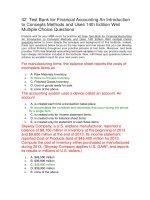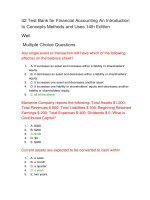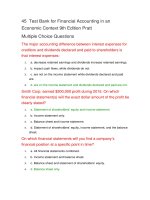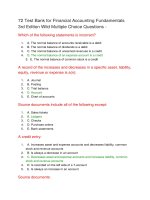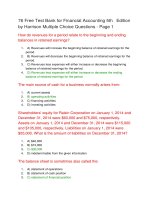77 test bank for financial accounting an introduction to concepts methods and uses 13th
Bạn đang xem bản rút gọn của tài liệu. Xem và tải ngay bản đầy đủ của tài liệu tại đây (122.8 KB, 25 trang )
77 Test Bank for Financial Accounting An Introduction to
Concepts Methods and Uses 13th
Edition by Stickney Multiple Choice Questions-Page 1
The balance sheet of Old Gold Mines, a gold mining company, for
the year ended June 30, 2009, showed current assets of $6 million,
noncurrent assets of $49 million, noncurrent liabilities of $14 million,
and current liabilities of $4 million. Compute the amount of
shareholders’ equity on Old Gold Mines’ balance sheet at the end of
2009.
1.
$14 million
2.
$27 million
3.
$33 million
4.
$37 million
5.
$41 million
The income statement of Peoples Motors Corporation, a U.S.
automotive manufacturer, for the year ended December 31, 2009,
reported revenues of $207,000, cost of sales of $165,000, other
operating expenses, including income taxes of $50,000, and net
financing income, after taxes, of $6,000. Compute the amount of
net income or loss that Peoples Motors reported for 2009.
1.
net income of $0
2.
net income of $2,000
3.
net loss of $2,000
4.
net income of $8,000
5.
net loss of $8,000
The _____ report changes in assets and liabilities over a period of
time, similar to a motion picture.
1.
balance sheet and income statement
2.
income statement and statement of cash flows
3.
balance sheet and statement of cash flows
4.
statement of cash flows and funds flow statement
5.
balance sheet and statement of cash receipts and disbursements
Net income that is not paid to shareholders as dividends increases
_____.
1.
cash receipts
2.
retained earnings
3.
cash disbursements
4.
long-term liabilities
5.
current liabilities
The _____ matches revenues with the costs associated with
earning those revenues and is not sensitive to the timing of
expenditures.
1.
tax basis of accounting
2.
modified accrual basis of accounting cash basis of accounting
3.
accrual basis of accounting
4.
present value basis of accounting
Revenues are:
1.
cash payments from customers
2.
outflows of assets to customers
3.
cash receipts from customers
4.
inflows of assets from customers
5.
sensitive to the timing of cash receipts from customers
A(n) _____ item is expected to generate cash over periods longer
than a year or use cash over periods longer than a year.
1.
illiquid
2.
long-term
3.
liquid
4.
current
5.
noncurrent
A _____ year ends on a date that is determined by the firm,
perhaps based on its business model (for example, many retailers
choose the end of January).
1.
physical
2.
natural
3.
fiscal
4.
business cycle
5.
normal
_____ are the amounts at which items entered the firm’s balance
sheet and reflect economic conditions at the time the firm obtained
assets or obtained financing.
1.
Past amounts
2.
Present amounts
3.
Valuation amounts
4.
Historical amounts
5.
Current amounts
The income statement of Ride-on Motors, an automotive
manufacturer, for the year ended December 31, 2009, reported
revenues $7,400 million and cost of sales of $6,000 million. In
addition, it reported other operating expenses of $900 million, a loss
of $2 million on the sale of a business, and net financing income of
$200 million. Tax expense for the year was $100 million. Compute
the amount of net income or loss that Ride-on Motors reported for
2009.
1.
net income of $198 million
2.
net income of $698 million
3.
net loss of $698 million
4.
net income of $598 million
5.
net loss of 598 million
Most firms report the amounts in their financial statements using
_____.
1.
Euro’s
2.
United States Dollars
3.
Japanese Yen
4.
5.
currency of the country where they are incorporated and conduct most of their
business activities
Swiss Francs
Investments in long-lived assets, with useful lives (or service lives)
that can extend for several or many years such as land, buildings,
and equipment represent _____ capital.
1.
sunk
2.
hard
3.
physical
4.
intangible
5.
soft
The _____ shows assets, liabilities and shareholders’ equity as of a
specific date, similar to a snapshot.
1.
balance sheet
2.
income statement
3.
statement of cash flows
4.
statement of sources and uses of funds
5.
statement of cash receipts and disbursements
The balance sheet of Allhear, a communications firm, for the year
ended December 31, 2009, showed current assets of $20 million,
current liabilities of $16 million, shareholders’ equity of $17 million,
and noncurrent assets of $29 million. Compute the amount of
noncurrent liabilities on Allhear’s balance sheet at the end of 2009.
1.
$5 million
2.
$10 million
3.
$12 million
4.
$13 million
5.
$16 million
The statement of cash flows for Lights-On, a leading electric utility
for the year ended December 31, 2009, showed a net cash inflow
from operations of $427,000 million and a net cash outflow for
financing of $21,800 million. The comparative balance sheets
showed a balance in cash of $32,700 at December 31, 2008, and
$101,200 at December 31, 2009. Compute the net amount of cash
provided or used by Lights-On’s investing activities for 2009.
1.
$68,500 million provided
2.
$271,300 million used
3.
$372,500 million provided
4.
$336,700 million used
5.
$236,700 million used
_____ represent amounts owed by customers for goods and
services they have already received. The customer, therefore, has
the benefit of the goods and services before it pays cash.
1.
Accounts Payable
2.
Accounts Receivable
3.
Notes Receivable
4.
Notes Payable
5.
Uncollected Sales
Who provides an opinion that reflects their professional conclusions
regarding the financial statements and for most publicly traded firms
in the U.S. also provides a separate opinion on the effectiveness of
the firm’s internal controls over financial reporting?
1.
management
2.
controller
3.
financial vice-president
4.
independent auditor
5.
general counsel
The _____ is the government agency that enforces the securities
laws of the U.S., including those that apply to financial reporting.
1.
Government Accountability Office (GAO)
2.
Public Company Accounting Oversight Board (PCAOB)
3.
International Accounting Standards Board (IASB)
4.
Financial Accounting Standards Board (FASB)
5.
U.S. Securities and Exchange Commission (SEC)
The _____ shows the relation between net income and cash flows
from operations, and changes in assets and liabilities that involve
cash flows.
1.
balance sheet
2.
statement of cash flows
3.
income statement
4.
funds flow statement
5.
cash receipts and cash disbursement statement
Expenses are:
1.
inflows of assets from customers
2.
cash receipts from customers
3.
outflows of assets from generating revenues
4.
cash payments
5.
sensitive to the timing of expenditures
_____ reflect values at the balance sheet date, so they reflect that
day’s economic conditions.
1.
Historical amounts
2.
Current amounts
3.
Present amounts
4.
Liquidation amounts
5.
Discounted cash flow amounts
The balance sheet of Copper Industries, a producer of copper,
showed retained earnings of $26,000 million at March 31, 2008. At
March 31, 2009, the balance in retained earnings was $70,500
million . Copper declared dividends during the year ended March
31, 2009, of $3,500 million . Compute Copper’s net income for the
year ended March 31, 2009 (fiscal 2008).
1.
$41.000 million
2.
$44.500 million
3.
$48.000 million
4.
$53.500 million
5.
$58.000 million
The number of days between when the employees and suppliers
provide goods and services and when the firm pays cash to those
employees and suppliers is called the _____ period.
1.
financing
2.
grace
3.
float
4.
funds flow
5.
cash disbursement
The balance sheet of Old Gold Mines for the year ended June 30,
2009, showed a balance in retained earnings of $6,000 million at
the end of 2009 and $4,600 million at the end of 2008. Net income
for 2009 was $2,400, million. Compute the amount of dividends Old
Gold Mines declared during 2009.
1.
$500 million
2.
$1,000 million
3.
$1,500 million
4.
$2,000 million
5.
$2,500 million
Which of the following is true regarding the investing activities of
charitable organizations?
1.
are not similar to business firms
2.
acquire productive capacity (for example, buildings) to carry out their activities
3.
issue common stock
4.
issue bonds
5.
issue preferred stock
A _____ connects two successive balance sheets because it
explains the change in cash from operating, financing, and investing
activities.
1.
statement of cash receipts and disbursements
2.
income statement
3.
funds flow statement
4.
statement of cash flows
5.
statement of retained earnings
Broke Inc is experiencing a cash flow problem finding that its cash
decreases, even though net income increases. Which of the
following is a possible reason?
1.
lag between cash expenditures incurred in producing goods and cash
collections from customers once the firm sells those goods
2.
must generally produce more units than it sells during a period of growth if it is
to have sufficient quantities of inventory on hand for future sales
3.
cash needed for a higher level of production exceeds the cash received from
the prior period's sale
4.
all of the above
5.
none of the above
A _____ item is expected to result in a cash receipt or a cash
payment within approximately one year or less.
1.
illiquid
2.
long-term
3.
current
4.
noncurrent
5.
liquid
Which of the following are true regarding setting goals and
strategies for a charitable organization?
1.
obtain sufficient resources to fund operations
2.
not pursue profits or wealth increases as goals.
3.
direct efforts toward providing services to constituencies
4.
all of the above are true
5.
none of the above are true
_____ is a private-sector financial accounting standard setter that
promulgates accounting standards that are required or permitted to
be used in over 100 countries, but has no enforcement powers.
1.
Financial Accounting Standards Board (FASB)
2.
International Accounting Standards Board (IASB)
3.
Public Company Accounting Oversight Board (PCAOB)
4.
U.S. Securities and Exchange Commission (SEC)
5.
Governmental Accountability Office (GAO)
Which of the following are true regarding the financing of a
charitable organization?
1.
may obtain some or all of its financing from donations (contributions)
2.
does not issue common stock or other forms of shareholders’ equity
3.
does not have retained earnings
4.
all of the above are true
5.
none of the above are true
An income statement connects two successive _____ through its
effect on retained earnings.
1.
balance sheets
2.
cash flow statements
3.
cash receipts and disbursement statements
4.
funds flow statements
5.
financing statements
Who under the oversight of the firm’s governing board, prepares the
financial statements?
1.
independent auditor
2.
Securities and Exchange Commission
3.
Public Companies Accounting Oversight Board
4.
general counsel
5.
management
_____ must be used by U.S. Securities and Exchange Commission
(SEC) registrants.
1.
U.S. GAAP
2.
International Financial Reporting Standards (IFRS)
3.
U.S. GAAS
4.
International GAAP
5.
International GAAS
Who evaluates the accounting system, including its ability to record
transactions properly and its operational effectiveness, and also
determines whether the financial reports prepared conform to the
requirements of the applicable authoritative guidance?
1.
management
2.
general counsel
3.
independent auditor
4.
financial vice-president
5.
controller
The _____ is the private-sector financial accounting standard setter
in the U.S., but has no enforcement powers.
1.
Financial Accounting Standards Board (FASB)
2.
Government Accountability Office (GAO)
3.
International Accounting Standards Board (IASB)
4.
Public Company Accounting Oversight Board (PCAOB)
5.
Accounting Standards Board
Which of the following is not true regarding the operations of a
charitable organization?
1.
might prepare financial statements that compare inflows (for example,
contributions) with outflows
2.
there would be no calculation of net income
3.
purpose is to provide services to its constituents
4.
purpose is to seek profits.
5.
all of the above
The purpose of the conceptual framework developed by the
Financial Accounting Standards Board (FASB) is to guide?
1.
alternative rule making decisions
2.
enforcement decisions
3.
academic research and study
4.
Congressional decision-makers
5.
standard setting decisions
The statement of cash flows for Goal Corporation, a U.S. retailer,
for the year ended February 2, 2009 (fiscal 2008), showed a net
cash inflow from operations of $4,100 million, a net cash outflow for
investing of $6,200 million, and a net cash inflow for financing of
$3,700 million. The balance sheet at February 3, 2008, showed a
balance in cash of $800 million.. Compute the amount of cash on
the balance sheet at February 2, 2009.
1.
$800 million.
2.
$1,600 million.
3.
$2,400 million.
4.
$3,200 million.
5.
$4,700 million.
77 Free Test Bank for Financial Accounting An
Introduction to Concepts Methods and Uses 13th Edition
by Stickney Multiple Choice Questions-Page 2
_____ measure the outflow of assets (or increases in liabilities)
used in generating revenues.
1.
Revenues
2.
Expenses
3.
Cash inflows
4.
Cash-outflows
5.
Shareholder equity
In 2007 the U.S. SEC adopted new rules that permit _____ that list
and trade their securities in the United States to apply IFRS in their
financial reports filed with the SEC without any reconciliation to U.S.
GAAP.
1.
U.S. SEC registrants
2.
non-U.S. SEC registrants
3.
EU SEC registrants
4.
Chinese SEC registrants
5.
all of the above
_____ are creditors’ claims for funds, usually because they have
provided funds, or goods and services, to the firm.
1.
Revenues
2.
Expenses
3.
Liabilities
4.
Assets
5.
Shareholder Equity
To carry out their plans, firms require financing, that is, funds from
owners and creditors. When the firm raises funds from owners,
which of the following is true?
1.
there is no obligation to repay these funds
2.
there is an obligation to repay these funds firms must distribute cash
dividends to that firm’s shareholders at least annually
3.
firm must distribute stock dividends to that firm’s shareholders at least
annually
4.
none of the above are true
Regulatory bodies generally require firms whose securities trade
publicly (for example, common shares) to obtain an audit of their
financial reports by _____.
1.
the audit committee
2.
the vice-president for finance
3.
an internal auditor.
4.
an independent external auditor.
5.
the controller
The income statement and statement of cash flows provide
information about the _____, respectively, of a firm during a period.
1.
asset and equity position at a moment in time and profitability
2.
asset and equity position at a moment in time and liquidity
3.
liquidity and profitability
4.
profitability and liquidity
5.
none of the above
FASB board members make standard-setting decisions guided by a
conceptual framework that addresses the qualitative characteristics
of accounting information. Which of the qualitative characteristics of
accounting information holds that the information should be
pertinent to the decisions made by users of financial statements, in
the sense of having the capacity to affect their resource allocation
decisions?
1.
Relevance
2.
Reliability
3.
Comparability.
4.
Subjective
5.
all of the above
The cash basis of accounting, as a basis for measuring
performance for a particular accounting period, has which of the
following weakness(es)?
1.
does not adequately match the cost of the efforts required to generate inflows
with the inflows themselves
2.
separates the recognition of revenue from the process of earning those
revenues.
3.
sensitive to the timing of cash expenditures
4.
all of the above
5.
none of the above
Examples of factors from the operating environment that would
affect a firm’s goals and strategies include which of the following?
1.
2.
goals and strategies of the firm’s competitors
barriers to entry of the firm’s industry, such as patents or large investments in
buildings and equipment
3.
nature of the demand for the firm’s products and services
4.
existence and nature of government regulation
5.
all of the above
To increase cash flow, a manufacturer might:
1.
delay paying its suppliers
2.
borrow from a bank using the inventory as collateral
3.
institute a just-in-time inventory system
4.
all of the above
5.
none of the above
_____ reports information about cash generated from (or used by)
operating, investing, and financing activities during specified time
periods.
1.
Statement of sources and uses of cash
2.
Statement of cash flows
3.
Statement of cash receipts and disbursements
4.
Funds flow statement
5.
Balance sheet
_____ refers to converting a noncash item to cash, for example,
collecting an account receivable.
1.
Actualization
2.
Recognition
3.
Realization
4.
Materialization
5.
Transformation
In the United States, regulatory requirements applicable to publicly
traded firms require the inclusion of a(n) _____, in which
management discusses operating results, liquidity (sources and
uses of cash), capital resources, and reasons for changes in
profitability and risk during the past year.
1.
Balance sheet or statement of financial position
2.
Management’s Discussion and Analysis
3.
Income statement or statement of profit and loss
4.
Statement of cash flows.
5.
Statement of shareholders’ equity.
Firms communicate the results of their business activities in the
_____.
1.
annual report to shareholders
2.
weekly press releases
3.
monthly press releases
4.
annual press releases
5.
annual income tax returns
To carry out their plans, firms require financing, that is, funds from
owners and creditors. Owners provide funds to a firm and in return
receive ownership interests. For a corporation, the ownership
interests are:
1.
Common Stock Shares
2.
Corporate Bonds
3.
Notes Receivable
4.
Notes Payable
5.
Certificates of Deposit
_____ captures the qualitative notion that financial reports need not
include items that are so small as to be meaningless to users of the
reports.
1.
Maximization
2.
Realization
3.
Recognition
4.
Materiality
5.
Minimization
To reduce the lag on collection of accounts receivable, a company
might
1.
offer a discount if customers pay quickly
2.
charge interest if customers delay payment
3.
use the accounts receivable as a basis for external financing
4.
sell only for cash
5.
all of the above
_____ are the means for achieving goals.
1.
Targets
2.
Strategies
3.
Objectives
4.
Milestones
5.
Tasks
The _____ basis of accounting typically recognizes revenue when a
firm sells goods (manufacturing and retailing firms) or renders
services (service firms), and recognizes expenses in the period
when the firm recognizes the revenues that the costs helped
produce.
1.
cash
2.
accrual
3.
funds flow
4.
tax
5.
none of the above
6.
Correct Feedback accrual
7.
Incorrect Feedback accrual
A firm makes investments to obtain productive capacity to carry out
its business activities. Investing activities involve acquiring all of the
following except:
1.
land, buildings, and equipment.
2.
patents, licenses, and other contractual rights
3.
common shares or bonds of other firms
4.
long-term notes receivable of other firms
5.
common shares or bonds of the firm
Management, under the oversight of the firm’s governing board (or
boards), sets the firm’s strategies. Such strategies might include:
1.
determining the firm’s lines of business
2.
determining the firm’s geographic locations
3.
degree to which a given business unit will engage in new product
development
4.
all of the above
5.
none of the above
When creditors provide funds to a firm, which of the following is
true?
1.
the firm must repay, usually with interest, in specific amounts at specific
dates.
2.
long-term creditors require repayment from the borrower over a period of time
that exceeds one year.
3.
4.
5.
one common form of long-term financing is bonds
suppliers of raw materials or merchandise that do not require payment for 30
days provide short-term funds
all of the above are true
_____ are the end results toward which the firm directs its
energies.
1.
Goals
2.
Strategies
3.
Objectives
4.
Activities
5.
Milestones
The _____ is an independent accounting standard-setting entity
with 14 voting members from a number of countries.
1.
Public Companies Accounting Oversight Board (PCAOB)
2.
International Accounting Standards Board (IASB)
3.
American Institute of Certified Public Accountants (AICPA)
4.
World Institute of Certified Public Accountants (WICPA)
5.
International Institute of Certified Public Accountants (IICPA)
_____ are economic resources with the potential to provide future
economic benefits to a firm.
1.
Revenues
2.
Expenses
3.
Liabilities
4.
Assets
5.
Shareholder Equity
What inventory system requires ordering raw materials only when
needed in production and manufacturing products only to customer
orders?
1.
first-in, first-out inventory
2.
last-in, first-out inventory
3.
weighted average inventory
4.
specific identification
5.
just-in-time inventory
_____ measure the inflows of assets (or reductions in liabilities)
from selling goods and providing services to customers.
1.
Revenues
2.
Expenses
3.
Cash inflows
4.
Cash-outflows
5.
Shareholder equity
FASB board members make standard-setting decisions guided by a
conceptual framework that addresses the qualitative characteristics
of accounting information. Which of the qualitative characteristics of
accounting information holds that the information should facilitate
comparisons across firms and over time.
1.
Relevance
2.
Reliability
3.
Comparability.
4.
Subjective
5.
all of the above
_____ items are depicted in words and numbers on the face of the
financial statements, with amounts included in the totals.
1.
Recognized
2.
Realized
3.
Actualized
4.
Objective
5.
Relevant
Management operates the productive capacity of the firm to
generate earnings. Operating activities include the following except
for:
1.
Purchasing
2.
Research and development
3.
Marketing and administration.
4.
Production
5.
Dividend payments
To increase the margin between selling price and manufacturing
cost, a manufacturing company might:
1.
2.
negotiate a lower purchase price with suppliers of raw materials
substitute more efficient manufacturing equipment for work now done by
employees
3.
increase selling prices.
4.
all of the above
5.
none of the above
Which of the following is not a business:activity?
1.
Establishing goals and strategies
2.
Obtaining financing
3.
Making investments
4.
Conducting operations.
5.
all of the above are business activities
The managers of a business prepare financial statements to
present meaningful information about that business’s activities to
external users. Who are the external users?
1.
owners
2.
lenders
3.
regulators
4.
tax authorities
5.
all of the above
FASB board members make standard-setting decisions guided by a
conceptual framework that addresses the qualitative characteristics
of accounting information. Which of the qualitative characteristics of
accounting information holds that the information should represent
what it is supposed to represent, in the sense that the information
should correspond to the phenomenon being reported, and it should
be verifiable and free from bias?
1.
Relevance
2.
Reliability
3.
Comparability.
4.
Subjective
5.
all of the above
An audit by an independent external auditor usually does not
involve which of the following?
1.
2.
an assessment of the capability of a firm’s accounting system to accumulate,
measure, and synthesize transactional data properly.
an assessment of the operational effectiveness of the accounting system
3.
a determination of whether the financial report complies with the requirements
of the applicable authoritative guidance
4.
an assessment of the operational economy, efficiency, and effectiveness of
the company’s operations
5.
an assessment of the effectiveness of a firm’s internal control system for
financial reporting.
Concerns over the quality of financial reporting have led, and
continue to lead, to government initiatives in the United States. For
example, the _____, among other things, established the Public
Company Accounting Oversight Board (PCAOB), which is
responsible for monitoring the quality of audits of SEC registrants.
This Act requires the PCAOB to register firms conducting
independent audits of SEC registrants; establish or adopt
acceptable auditing, quality control, and independence standards;
and provide
1.
Securities and Exchange Act of 1933
2.
Securities and Exchange Act of 1934
3.
Investment Advisors Act of 1940
4.
Sarbanes-Oxley Act of 2002
5.
Investment Company Act of 1940
The financial statements present aggregated information, for
example, the total amount of land, buildings, and equipment.
Financial reports provide more detail for some of the items reported
in the financial statements, and they provide additional explanatory
material to help the user to understand the information in the
financial statements. This information appears in _____ that are an
integral part of the financial reports.
1.
management’s discussion and analysis
2.
external auditors report
3.
internal auditors report
4.
press releases
5.
schedules and notes
Which of the following is true?
1.
A firm without sufficient cash will not survive.
2.
A firm operating profitably will always survive.
3.
Examining the cash receipts and disbursements during each month can
identify the reasons for any deterioration of the cash balance.
4.
a and c
5.
all of the above
